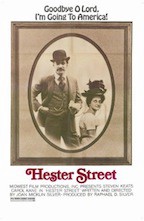Each year 25 films are added by the Library of Congress to the National Film Registry. This year included in the list is the ground breaking film Hester Street directed by Joan Micklin Silver. Silver was one of the first women to start directing in the 1970s after a period of years where there were hardly any female directors. She is a true pioneer. She’s also the director of one of my favorite films Crossing Delancey.
Here are the other female directed films included on the list: (descriptions from story in the Hollywood Reporter)
Fake Fruit Factory (1986)
An expressive, sympathetic look at the everyday lives of young Mexican women who create ornamental papier-mache fruits and vegetables, Fruit Factory exemplifies filmmaker Chick Strand’s unique style that deftly blends documentary, avant-garde and ethnographic techniques. After studying anthropology and ethnographic film at the University of California, Strand, who helped noted independent filmmaker Bruce Baillie create the independent film distribution cooperative Canyon Cinema, taught filmmaking for 24 years at Occidental College. She developed a collagist process to create her films, shooting footage of people she encountered over several decades of annual summer stays in Mexico and then editing together individual films. In Fruit Factory, Strand employs a moving camera at close range to create colorfully vivid images often verging on abstraction, while her soundtrack picks up snatches of conversation to evoke, in her words, “the spirit of the people.” “I want to know,” Strand wrote, “really what it is like to be a breathing, talking, moving, emotional, relating individual in the society.”
Growing Up Female (1971)
Among the first films to emerge from the women’s liberation movement, Growing Up Female is a documentary portrait of America on the brink of profound change in its attitudes toward women. Filmed in spring 1970 by Ohio college students Julia Reichert and Jim Klein, Female focuses on six girls and women ages 4 to 34 and the home, school, work and advertising environments that have impacted their identities. Through open-ended interviews and lyrical documentation of their surroundings, the film strived, in Reichert’s words, to “give women a new lens through which to see their own lives.” Widely distributed to libraries, universities, churches and youth groups, the film launched a cooperative of female filmmakers that bypassed traditional distribution mechanisms to get its message communicated.
Hester Street (1975)
Joan Micklin Silver’s first feature-length film, Hester Street was an adaption of preeminent Yiddish author Abraham Cahan’s 1896 well-received first novel Yekl: A Tale of the New York Ghetto. In the 1975 film, the writer-director brought to the screen a portrait of Eastern European Jewish life in America that historians have praised for its accuracy of detail and sensitivity to the challenges immigrants faced during their acculturation process. Shot in black-and-white and partly in Yiddish with English subtitles, the independent production, financed with money raised by the filmmaker’s husband, was shunned by Hollywood until it established a reputation at the Cannes Film Festival and in European markets. Hester Street focuses on stresses that occur when a “greenhorn” wife, played by Carol Kane (nominated for an Oscar for her portrayal), and her young son arrive in New York to join her Americanized husband. Silver, one of the first female directors of American features to emerge during the women’s liberation movement, shifted the story’s emphasis from the husband, as in the novel, to the wife. Historian Joyce Antler has written admiringly, “In indicating the hardships experienced by women and their resiliency, as well as the deep strains assimilation posed to masculinity, Hester Street touches on a fundamental cultural challenge confronting immigrants.”
Films about women also included are: Silence of the Lambs; Norma Rae; I, an Actress






